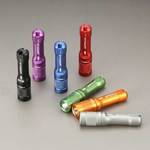First heard about this torch from a previous deal here but missed out.
In depth review at Budget Light Forum. Feedback looks good.
Rotary switch
4 modes - Low, Mid, High & Strobe (thankfully the annoying strobe mode is somewhat hidden in that you have to cycle twice through L>M>H to activate)
Single AAA
Price comes down to $11.90ea if you buy 3 or more.




Thank you OP. I bought blue, green, orange, and purple.